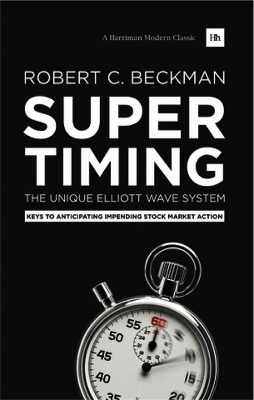
Supertiming: The Unique Elliott Wave System
Harriman House Publishing (Verlag)
978-0-85719-340-7 (ISBN)
This is the classic work on Elliott Wave and market cycles returned to print. During the 1930s, R. N. Elliott undertook the painstaking procedure of attempting to classify share price movements for the preceding 80 years on Wall Street. It was during the course of this seminal work that Elliott discovered a definable basic rhythm in share price movements which he felt had forecasting value when correctly applied. In 1938 Elliott published his findings in a series of articles with the overall title "The Wave Principle". After publication, Elliott's work drifted into obscurity, until Robert Beckman's 'Supertiming' introduced it to a new audience. In this renowned work, Beckman sets out with three main objectives: to clarify obscurities and grey areas of The Wave Principle that were present in Elliott's original writing; to incorporate the work of other analysts in order to allow the Wave Principle to have a broader application; and to show the correct conceptual approach that should be used with the Wave Principle so that one can apply it with confidence and consistency.If you are willing to approach the subject of stock market behaviour with an open mind, who have faith in the fundamental laws of economics and the consistency of human nature, and who would like to avoid the pitfalls that have deluded the investment community for decades, this is the book for you.
Beckman's background includes formal training as an economist. He is also an ex-Wall Street stockbroker, market trader, fund manager, financial journalist, lecturer and author of seven books on the subject of investment.
Publisher's Preface Introduction One: The Origins of the Wave Principle First contacts with Wall Street Elliott and the Economists The Grand Super Cycle The Five-wave Concept The Need to be a Genius? Two: Reality in the Stock Market $2,000 to $1,000,000 The Future not the Past Cyclical Nature of the Market Time Frame Relative - not Fixed Classification of Waves Three: Elliott... Pure and Simple A Rhythmic Pattern of Waves Elliott's Five Basic Tenets Bull Market - Bear Market Ground Rules Application to Investment Strategy Probabilities not Absolutes Practice Runs Four: "Like a Circle in a Spiral, a Wheel within a Wheel" The Wave Count Breakdown of Primary Market Cycle Pivotal Points 1984 Normality and Variations The Market is Always Right Improving Investment Performance Five: The Fibonacci Summation Series The Series W. D. Gann's Numerical Approach The Fibonacci Series in Art and Nature Examples from Nature's Law Fibonacci and Cyclical Behaviour Brilliant... or Ludicrous? Open Mind - Successful Investment Six: Applying the Fibonacci Series Choice of Stock Exchange Data A Psychological Phenomenon Pattern Time Ratio Calculations and Examples The "Non-Absolute" Nature of Elliott Stock Market History and the Summation Series Seven: The Trend Channel Logarithmic and Arithmetic Scales Forecasting using Trend Channels Frames of Reference, not Predictions Deviations from "Normative" Behaviour F.T.30, January 1975-February 1976 Eight: Elliott, Inflation and the Fifth Wave Inflation in Britain Inflation in the U.S.A. and Fibonacci Early Warnings of Inflation Extensions Extensions of Extensions Retracements and Double Retracements Double Retracement and the Extended Fifth Wave Nine: Incorrigible Behaviour Extensions in the Corrective Phase Corrective Wave Formations - "Zigzag" Maximum Corrective Action Use in Investment Strategy Further Corrective Wave Formations The "Flat" "Irregular Corrections" Ten: "Double Threes", "Triple Threes", "Horizontals", "Triangles"... and all that! Complex Corrections Triangles and Horizontals The Tension in the Triangle Enlargement of Corrections Use of the Time Factor Action after the Corrective Wave Eleven: The Finishing Touches Breakdown of the Impulse Waves Elliott's Theory of Alternation Erroneous Counting "Failures" "Thrusts" Volume Moving Averages Ancillary Indicators Twelve: Practical Application of the Wave Principle Terminal Endings The Next Ten Years Sequence for Selling Trading Intermediate Term Movements Confirmation of Terminal Junctures Applications to Individual Share Price Movements The Final Word Appendix: "The Wave Principle" Introducing "The Wave Principle" The Wave Principle: Part II The Wave Principle: Part III The Wave Principle: Part IV The Wave Principle: Part V The Wave Principle: Part VI The Wave Principle: Part VII The Wave Principle: Part VIII The Wave Principle: Part IX The Wave Principle: Part X The Wave Principle: Part XI The Wave Principle: Part XII Bibliography
| Erscheint lt. Verlag | 19.3.2014 |
|---|---|
| Zusatzinfo | 1, colour illustrations |
| Verlagsort | Petersfield |
| Sprache | englisch |
| Maße | 140 x 216 mm |
| Gewicht | 290 g |
| Themenwelt | Natur / Technik ► Fahrzeuge / Flugzeuge / Schiffe ► Schienenfahrzeuge |
| Wirtschaft ► Betriebswirtschaft / Management ► Finanzierung | |
| ISBN-10 | 0-85719-340-6 / 0857193406 |
| ISBN-13 | 978-0-85719-340-7 / 9780857193407 |
| Zustand | Neuware |
| Haben Sie eine Frage zum Produkt? |
aus dem Bereich


